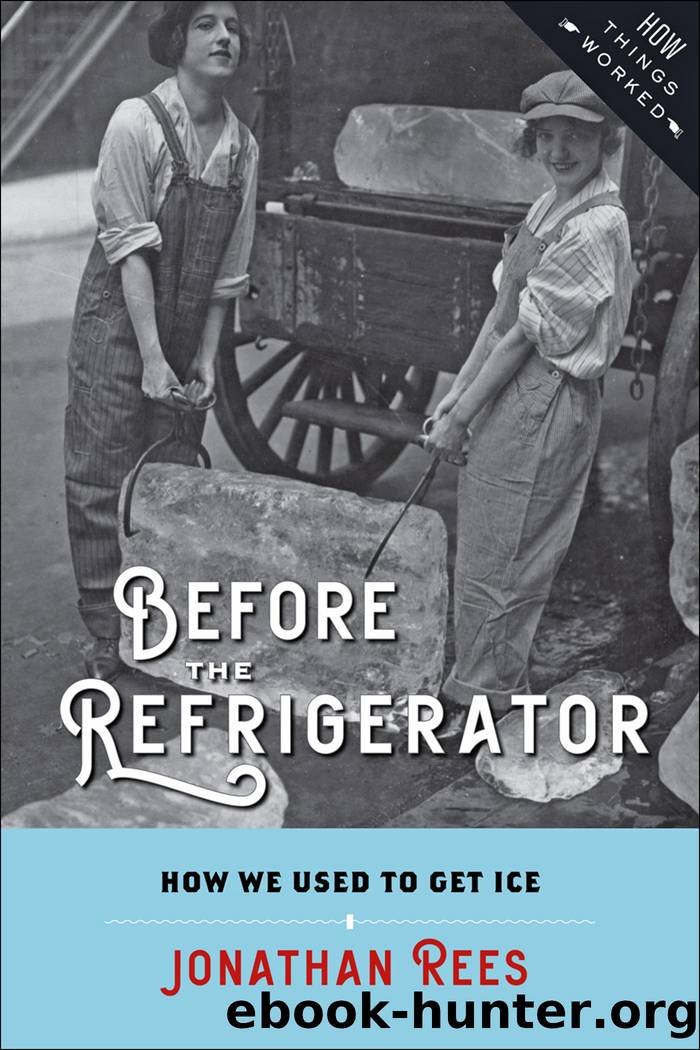Before the Refrigerator by Jonathan Rees

Author:Jonathan Rees [Rees, Jonathan]
Language: eng
Format: epub
ISBN: 9781421424606
Published: 2018-02-14T16:00:00+00:00
4 How Ice Changed the American Diet and American Life
BY 1900, THE ICE INDUSTRY HAD BECOME thoroughly modernized. Output was high. Machines both produced ice and helped harvest still more. Ice machines were efficient enough that they had begun to spread to even the most northern parts of the country. These machines could supply ice on demand, whenever necessary. In short, the industry had practically overcome the limitations once imposed on it by the weather. Ice famines, which had periodically caused prices to skyrocket earlier in the history of the industry, became a thing of the past. With a surplus of ice, the product could be used in ways that people never would have imagined when it was relatively rare.
For example, without greater access to ice (harvested or manufactured), brewers never would have been able to keep up with the demand for lager beer. In addition to railroad cars filled with ice for transportation, the meatpacking industry used ice to chill their factories. Besides expanding the range of distribution for perishable products of all kinds, refrigeration cut waste due to spoilage. This increased the supply of all perishable products, which in turn lowered their price and therefore made it easier for more people to consume it. In some cases, the increased availability of ice also made those products safer to consume since they were preserved better throughout their journey along the cold chain.
Milk is an excellent example of this last impact. It takes less than two days for fresh milk to spoil without refrigeration. Dairy farms were much closer to urban markets at the turn of the twentieth century than they are today, but they were also much smaller and more numerous. That meant that milk had to be collected from a large number of farms and stored before it could be distributed through the middlemen who retailed it. All this milk required refrigeration along the way, or it would spoil before reaching the consumer. Before refrigerated trucks, that refrigeration generally came from ice.1 A 1915 ad for an El Paso milk producer bragged that they were âthe only dairy that uses ice machines to rapidly cool and preserve the milk.â Those machines also stocked the dairyâs delivery trucks with ice, keeping the cold chain as complete as possible until their product reached customersâ kitchens.2 Ice, and later mechanical refrigeration, filled in the holes along the cold chain for milk, keeping it fresh and healthier.
As these holes disappeared later in the twentieth century, not only milk consumption but the consumption of dairy products in general increased sharply. For example, between 1910 and 1940, butter consumption in the United States was four times greater than it has been in recent decades.3 Without ice refrigeration, much of the milk needed to make butter never would have survived the trip to the factory. The more refrigeration, the safer that milk would have been. In this way, the increased availability of ice made milk both tastier and healthier than it had been previously. In
Download
This site does not store any files on its server. We only index and link to content provided by other sites. Please contact the content providers to delete copyright contents if any and email us, we'll remove relevant links or contents immediately.
Zero to IPO: Over $1 Trillion of Actionable Advice from the World's Most Successful Entrepreneurs by Frederic Kerrest(4295)
Machine Learning at Scale with H2O by Gregory Keys | David Whiting(4183)
Never by Ken Follett(3793)
Harry Potter and the Goblet Of Fire by J.K. Rowling(3775)
Ogilvy on Advertising by David Ogilvy(3510)
Shadow of Night by Deborah Harkness(3303)
The Man Who Died Twice by Richard Osman(2997)
Book of Life by Deborah Harkness(2867)
The Tipping Point by Malcolm Gladwell(2827)
Will by Will Smith(2793)
0041152001443424520 .pdf by Unknown(2784)
My Brilliant Friend by Elena Ferrante(2774)
How Proust Can Change Your Life by Alain De Botton(2742)
Purple Hibiscus by Chimamanda Ngozi Adichie(2652)
How to Pay Zero Taxes, 2018 by Jeff A. Schnepper(2602)
Hooked: A Dark, Contemporary Romance (Never After Series) by Emily McIntire(2502)
Rationality by Steven Pinker(2291)
Borders by unknow(2229)
Can't Hurt Me: Master Your Mind and Defy the Odds - Clean Edition by David Goggins(2228)
